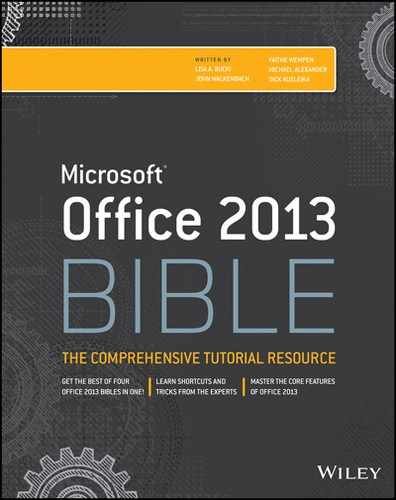Chapter 22
Working with Layouts, Themes, and Masters
IN THIS CHAPTER
Changing a slide’s layout
Applying a theme
Customizing theme formatting
Specifying repeated elements
Modifying a slide layout
Creating a new slide layout
Managing themes and layouts
Storing themes in custom templates
Most presentations consist of multiple slides, so you’ll need a way of ensuring consistency among them. Not only will you want each slide (in most cases) to have the same background, fonts, and text positioning, but you will also want a way of ensuring that any changes you make to those settings later automatically populate across all your slides.
To accomplish these goals, PowerPoint offers layouts, themes, and masters. Layouts determine the positioning of placeholders; themes assign color, font, and background choices; and masters transfer theme settings to the slides and provide an opportunity for repeated content, such as a logo, on each slide. In this chapter you learn how to use layouts, themes, and masters to create a presentation that is attractive, consistent, and easy to manage.
Understanding Layouts and Themes
As you learned in Chapter 21, a layout is a positioning template. The layout used for a slide determines what content placeholders will appear and how they will be arranged. For example, the layout shown in Figure 22.1 is called Title Slide, and it contains a Title placeholder and a Subtitle placeholder.
FIGURE 22.1 This slide uses the Title Slide layout and the Facet theme.
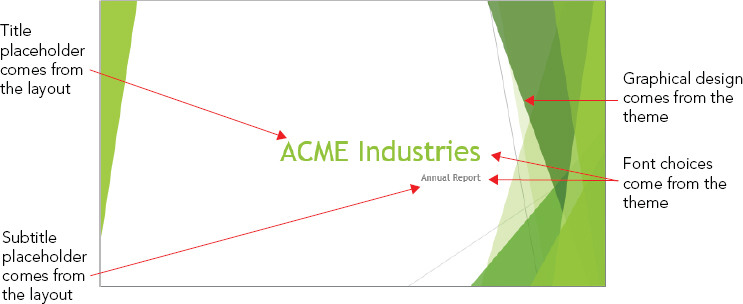
A theme is a group of design settings. It includes color settings, font choices, object effect settings, and in some cases also a background graphic. In Figure 22.1, the theme applied is called Facet, and it is responsible for the colored shapes and lines on the edges, the colors of those graphics, and the fonts used on the slide.
A theme is applied to a slide master, which is a sample slide and not part of the regular presentation, existing only behind-the-scenes to provide its settings to the real slides. It holds the formatting that you want to be consistent among all the slides in the presentation (or at least a group of them, because a presentation can have multiple slide masters). Technically, you do not apply a theme to a slide; you apply a theme to a slide master, and then you apply a slide master to a slide. That’s because a slide master can actually contain some additional elements besides the formatting of the theme such as extra graphics, dates, footer text, and so on.
Themes versus templates
As you learned in Chapter 20, a template is a file on which you can base new presentations. Templates typically have a .potx extension (or a .potm extension if macro-enabled). A template may contain one or more themes (that is, sets of design choices, like backgrounds, layouts, and font choices), plus one or more slides containing sample text.
A theme is both simpler than and more complex than a template. A theme can exist either inside of a template or as a separate file with a .thmx extension. A theme is simpler because it cannot hold some of the things a template can hold, such as sample content. A theme can provide only font, color, effect, and background settings to the presentation. (It can also provide slide layouts, discussed a bit later.) On the other hand, a theme can also do more than a PowerPoint template, in that you can apply a theme saved as a separate file to other Office applications, so you can share its color, font, and effect settings with Word or Excel, for example.
Where themes are stored
A theme is an XML file (or a snippet of XML code embedded in a presentation or template file). A theme can come from any of these sources:
- Built-in: Some themes are embedded in PowerPoint itself and are available from the Themes gallery on the Design tab regardless of the template in use.
- Custom (automatically loaded): The default storage location for user-created theme files in Windows 7 and 8 is C:Usersuser nameAppDataRoamingMicrosoftTemplatesDocument Themes. All themes (and templates containing themes) stored here are automatically displayed among the gallery of theme choices on the Design tab, in a Custom category.
TipIf you don’t want to delete a custom theme file, but you also don’t want it showing up in the gallery all the time, move the file to a folder outside of the Document Themes folder hierarchy. For example, create an Unused Themes folder on your hard disk and move it there until you need it. When you want to use the custom color theme again, move the file back to its original location.
- Inherited from starting template: If you start a presentation using a template other than the default blank one, that template might have one or more themes included in it.
- Stored in current presentation: If you modify a theme in Slide Master view while you are working on a presentation, the modified code for the theme is embedded in that presentation file.
- Stored in a separate file: If you save a theme (using any of a variety of methods you’ll learn later in this chapter), you create a separate theme file with a .thmx extension. These files can be shared among other Office applications, so you can standardize settings such as font and color choices across applications. (Some of the unique PowerPoint portions of the theme are ignored when you use the theme in other applications.)
Themes, layouts, and Slide Master view
In PowerPoint 2013, the slide master has separate layout masters for each layout, and you can customize and create new layouts. Look at Figure 22.2, which shows Slide Master view. Notice along the left side that there is a different, separately customizable layout master for each available layout, all grouped beneath the slide master. Any changes you make to the slide master trickle down to the individual layout masters, but you can also customize each of the individual layout masters to override a trickle-down setting. For example, on a particular layout you can choose to omit the background graphic to free up its space on the slide for extra content.
FIGURE 22.2 Slide Master view enables you to make design changes that affect the entire presentation.

A master is a set of specifications that govern overall formatting and appearance. PowerPoint actually has three masters: the slide master (for slides), the handout master (for handouts), and the notes master (for speaker notes). This chapter deals only with the slide master. For more on the handout and notes masters, see Chapter 25.
The slide master holds the settings from a theme and applies them to one or more slides in your presentation. A slide master is not exactly the same thing as a theme because the theme can also be external to PowerPoint and used in other programs, but there’s a rough equivalency there. A slide master is the representation of a particular theme applied to a particular presentation.
When you make changes to a slide master, those changes trickle down to the individual layout masters associated with it. When you make changes to an individual layout master, those changes are confined to that layout in that master only.
To enter Slide Master view, choose View ⇒ Master Views ⇒ Slide Master. A Slide Master tab appears. To exit from Slide Master view, choose Slide Master ⇒ Close ⇒ Close Master View or select a different view from the View tab.
Changing a Slide’s Layout
As you construct your presentation, you may find it useful to change a slide’s layout. For example, you might want to switch from a slide that contains one big content placeholder to one that has two side-by-side content placeholders, to compare/contrast two lists, drawings, or diagrams.
Many of the layouts PowerPoint provides contain multipurpose placeholders that accept various types of content. For example, the default layout, called Title and Content, has placeholders for a slide title plus a placeholder where you can choose a single type of content to insert — text, a table, a chart, a picture, a piece of clip art, a SmartArt diagram, or a video. You choose the layout you want based on the number and arrangement of the placeholders, and not the type of content that will go into them.
When you change to a different layout, PowerPoint changes the type and/or positioning of the placeholders on it according to the associated layout in the slide master. If the previous placeholders had content in them, that content shifts to a new location on the slide to reflect the different positioning for that placeholder type. If the new layout does not contain a placeholder appropriate for that content, the content remains on the slide but becomes orphaned. This means it is a free-floating object, outside of the layout. You need to manually position an orphaned object if it’s not in the right spot. However, if you later apply a different layout that does contain a placeholder for the orphaned object, it snaps back into that placeholder.
To switch a slide to a different layout, follow these steps:
FIGURE 22.3 Switch to a different layout for the selected slide(s).
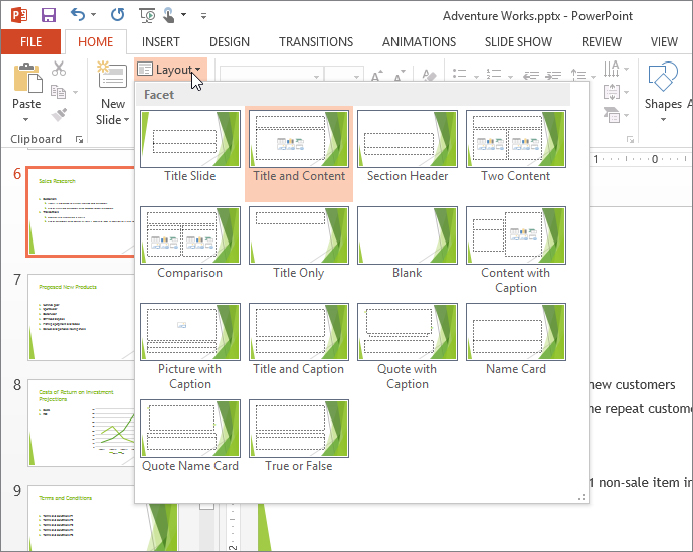
When a presentation has more than one slide master defined, separate layouts appear for each of the slide masters. Figure 22.4 shows the Layout menu for a presentation that has two slide masters.
FIGURE 22.4 When there are multiple slide masters, each one’s layouts are separate.
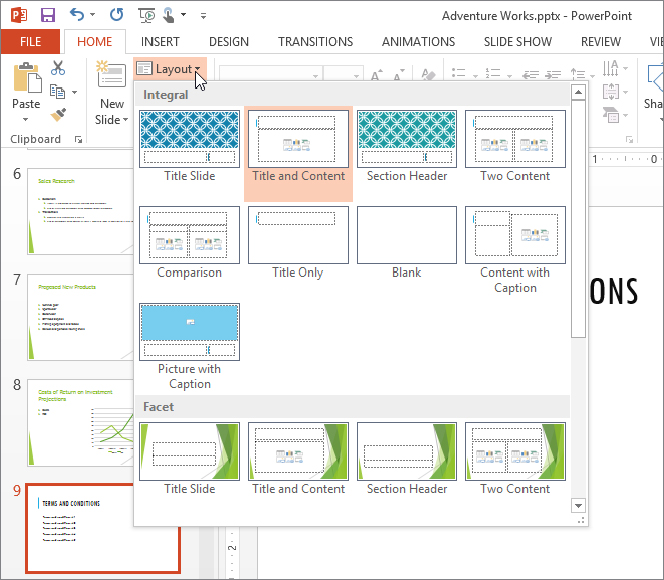
Applying a Theme
As you learned in “Understanding Layouts and Themes” at the beginning of this chapter, themes enable you to apply different designs to the presentation. A theme includes a background graphic (usually), color and font choices, and graphic effect settings. A theme can also include custom layouts.
The method for applying a theme depends on whether that theme is already available in the current presentation or not. Some themes are built into PowerPoint so that they are always available; other themes are available only when you use certain templates, or when you specifically apply them from an external file. The following sections explain each of those possibilities.
Applying a theme from the gallery
A gallery in PowerPoint is a menu of samples from which you can choose. You saw the Layout gallery in Figures 22.2 and 22.3, for example. The Themes gallery is a menu of all of the built-in themes plus any additional themes available from the current template or presentation file.
To select a theme from the gallery, follow these steps:
FIGURE 22.5 Open the Themes gallery by clicking the More button.

FIGURE 22.6 Select the desired theme from the gallery.
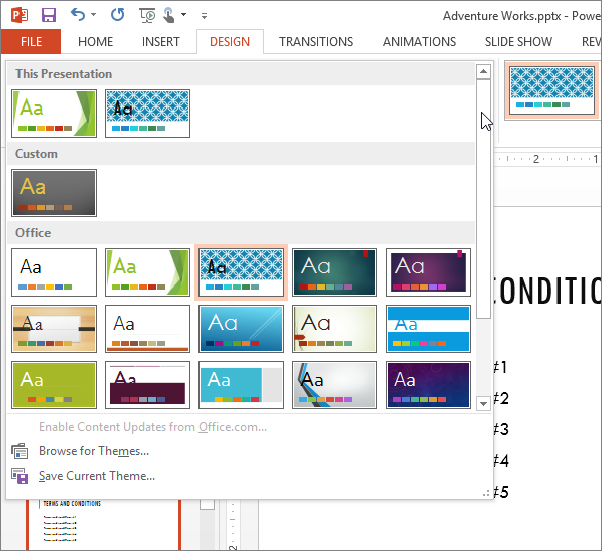
- If you selected multiple slides in step 1, the theme is applied only to them.
- If you selected a single slide in step 1, the theme is applied to the entire presentation.
To override the default behavior in step 3, so that you can apply a different theme to a single slide, right-click instead of clicking in step 3 and choose Apply to Selected Slide(s) from the shortcut menu.
Applying a theme from a theme or template file
You can open and use externally saved theme files in any Office application. This makes it possible to share color, font, and other settings between applications to create consistency between documents of various types. You can also save and load themes from templates. (To create your own theme files, see “Creating a new theme” later in this chapter.)
To apply a theme to the presentation from a theme or template file, follow these steps:
Applying a theme variant
Some themes come in several versions, called variants. These variants have the same basic slide layouts and background graphics as the original, but may have different color, font, and/or effect choices. For example, a theme that has a white background and black text might have a black-background variant with white text. Variants are new in PowerPoint 2013.
To apply a variant, first apply the desired theme, using any of the methods you learned about earlier in this chapter. Then, on the Design tab, click one of the variants in the Variants group. See Figure 22.7.
FIGURE 22.7 Select a variant for the chosen theme from the Design tab.

The Variants group, like the Themes group, has a More button (down-pointing arrow button with a line over it) that you can click to open up a full gallery of choices. However, most themes have only a few variants to choose from, so all the variants may already be visible without opening the gallery.
Managing Themes
Themes are applied to slide masters to specify the background, color, font, and effect formatting for all the slides that have that slide master assigned to them. (A single presentation file can have multiple slide masters, and therefore multiple themes.)
Some themes are built into PowerPoint, and you can also create and save your own themes as separate files and apply them to other presentations or even to other Office documents, such as in Word and Excel. In this section you learn how to create new themes, manage theme files, and apply themes across multiple presentations.
Creating a new theme
To create a new theme, first format a slide master exactly the way you want, including any custom layouts, backgrounds, colors, and font themes. (You will learn how to make those changes later in this chapter.) Then save the slide master’s formatting as a new theme by following these steps:
FIGURE 22.8 Save the current slide master’s settings as a new theme.
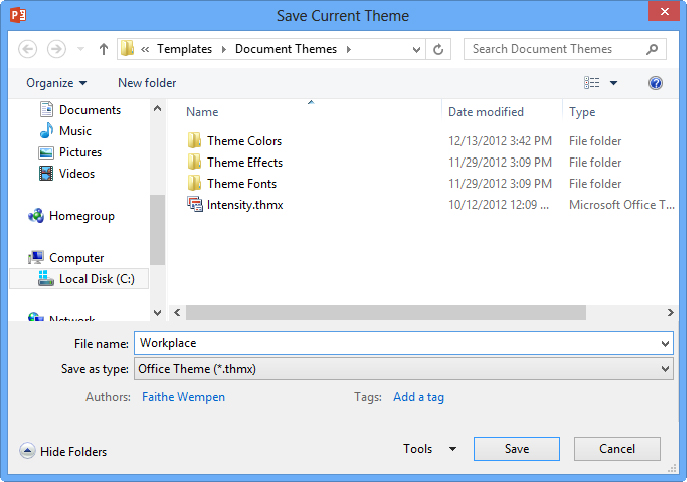
The new theme is now available from the Themes gallery in all presentations you create, as long as you are signed into Windows as the same user on the same PC. All of the theme’s formatting is available, including any custom color or font themes it includes. You can use the saved theme in other programs too; in Word or Excel, choose Page Layout ⇒ Themes in one of those programs.
Renaming a theme
You can rename a theme file by renaming the .thmx file from File Explorer (Windows Explorer in Windows 7), from outside of PowerPoint. By default, theme files are stored in: C:Usersuser nameAppDataRoamingMicrosoftTemplatesDocument Themes.
Don’t want to leave PowerPoint to do this? You can also rename a theme file from inside PowerPoint by using any dialog box that saves or opens files. For example, to use the Choose Theme or Themed Document dialog box to rename a theme, follow these steps:
FIGURE 22.9 Right-click the theme file and choose Rename.
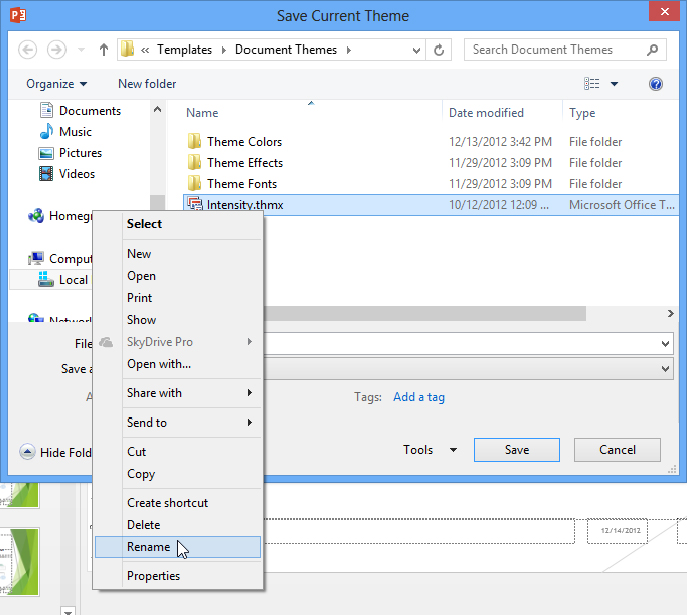
Deleting a theme
A custom theme file continues appearing on the Themes gallery indefinitely. If you want to remove it from there, you must delete it. The easiest way to delete a theme is to right-click it in the Themes gallery and choose Delete.
You can also browse to the folder containing your saved custom themes and delete from there. See the previous section, “Renaming a theme,” to learn an easy way to get access to that folder without leaving PowerPoint.
Copying a theme from another presentation
One easy way to copy a theme from one presentation to another is copy a slide master that has that theme applied to it. Follow these steps to learn how to do that:
Changing Colors, Fonts, and Effects
In addition to overall themes, which govern several types of formatting, PowerPoint also provides many built-in color, font, and effect themes that you can apply separately from your choice of design theme. So, for example, you can apply a design theme that contains a background design you like, as you learned to do earlier in this chapter, and then change the colors, fonts, and effects for it.
In the following sections, you’ll learn how to apply some of these built-in color, font, and effect settings to a presentation without changing the theme. For example, you might choose to make changes in the colors, fonts, and/or effects to customize a theme, and then save it as a custom theme, as you learned in “Creating a new theme” earlier in this chapter.
Understanding color placeholders
To understand how PowerPoint changes colors when you choose a different theme or variant, you must know something about how PowerPoint handles colors in general.
PowerPoint uses a set of color placeholders for the bulk of its color formatting. Because each item’s color is defined by a placeholder, and not as a fixed color, you can easily change the colors by switching to a different color theme. This way if you decide, for example, that you want all the slide titles to be blue rather than green, you make the change once and it is applied to all slides automatically.
A group of colors assigned to preset placeholders is a color theme. PowerPoint contains 20+ built-in color themes that are available regardless of the overall theme applied to the presentation. Because design themes use placeholders to define their colors, you can apply the desired design theme to the presentation and then fine-tune the colors afterward by experimenting with the built-in color themes.
How many color placeholders are there in a color theme? There are actually 12, but sometimes not all of them are available to be applied to individual objects. When you choose a color theme, the gallery of themes from which you choose shows only the first eight colors of each color theme. It doesn’t matter so much here because you can’t apply individual colors from there anyway. When selecting colors from a color picker (used for applying fill and border color to specific objects), as in Figure 22.10, there are 10 theme swatches. And when you define a new custom color theme, there are 12 placeholders to set up. The final two are for visited and unvisited hyperlinks; these colors aren’t included in a color picker.
FIGURE 22.10 PowerPoint uses color pickers such as this one to enable you to easily apply color placeholders to objects.
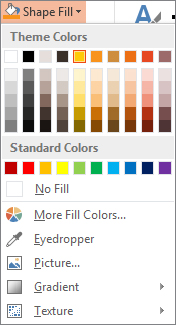
Changing the color theme
After applying the overall theme you want, you might want to apply different colors. One way to get different colors, as you saw earlier in this chapter, is to apply a variant. The variants are just the tip of the iceberg, though; many more color themes are available. To switch to a different color theme from Normal, Outline, or Slide Sorter views, choose Design ⇒ Variants ⇒ More button ⇒ Colors, and then click the desired color theme in the gallery.
Or, if you prefer to work in Slide Master view follow these steps:
FIGURE 22.11 Choose the desired color theme.

Understanding font placeholders
By default in most themes and templates, text box fonts are not set to a specific font, but to one of two designations: Heading or Body. Then a font theme defines what specific fonts to use as Heading and Body. To change the fonts across the entire presentation, all you have to do is apply a different font theme.
A font theme is an XML-based specification that defines a pair of fonts: one for headings and one for body text. Then that font is applied to the text boxes in the presentation based on their statuses of Heading or Body. For example, all of the slide titles are usually set to Heading, and all of the content placeholders and manual text boxes are usually set to Body.
In a blank presentation (default blank template), when you click inside a slide title placeholder box, you see Calibri Light (Headings) in the Font group on the Home tab. Figure 22.12 shows that the current font is Calibri Light, but that it is being used only because the font theme specifies it. You could change the font theme to Verdana/Verdana, for example, and then the font designation for that box would appear as Verdana (Headings). The word (Headings) might be truncated, as it is in Figure 22.12, if your PowerPoint window is not wide enough to allow it to display in full.
FIGURE 22.12 When some text is using a font placeholder rather than a fixed font, (Headings) or (Body) appears after its name in the Font group on the Home tab.

In some font themes, the same font is used for both headings and body. In many other font themes, though, the heading and body fonts are different. The default font theme for blank presentations is Calibri Light/Calibri — the same basic font, but with a thinner version for the headings.
Changing the font theme
After applying a design theme, you might decide you want to use different fonts in the presentation. To switch to a different font theme from Normal, Outline, or Slide Sorter views, choose Design ⇒ Variants ⇒ More button ⇒ Fonts, and then click the desired font theme in the gallery.
Alternately, in Slide Master view follow these steps:
FIGURE 22.13 Select the font theme you want for your slide.

Changing the effect theme
Effect themes apply to several types of drawings that PowerPoint can construct, including SmartArt, charts, and drawn lines and shapes. They make the surfaces of objects formatted with 3-D attributes look like different textures (more or less shiny-looking, colors more or less deep, and so on).
To change the effect theme from Normal, Outline, or Slide Sorter views, choose Design ⇒ Variants ⇒ More button ⇒ Effects, and then click the desired effect theme in the gallery.
Or, if you prefer to work in Slide Master view, follow these steps:
FIGURE 22.14 Select the desired effect theme.
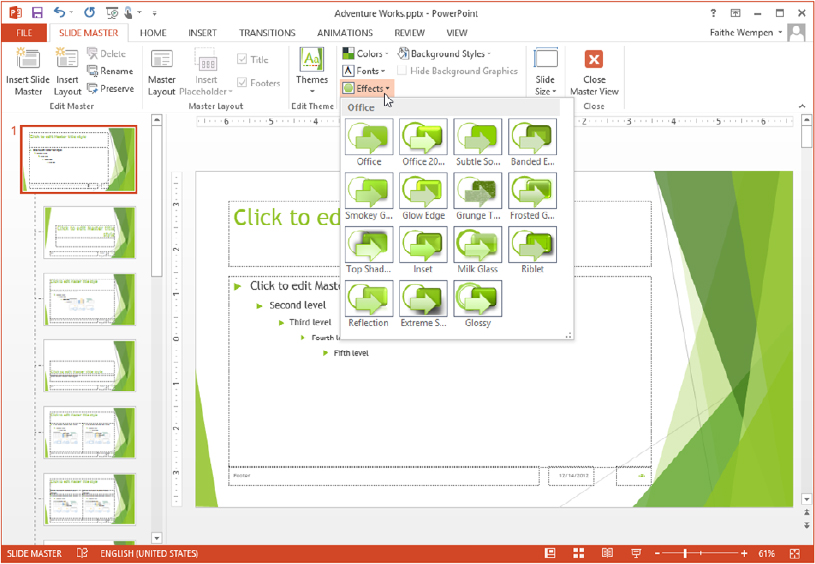
Creating a custom color theme
You can define your own custom color themes, and save them for reuse in other presentations. By default, these are saved in the personal folders for the logged-in user on the local PC, and they remain available to that user regardless of the theme or template in use. These custom color themes are also included if you save the design theme as a separate theme file (.thmx), so that you can take those settings to another PC or send them to some other user.
A custom color theme defines specific colors for each of the 12 color placeholders (including the two that you can’t directly use — the ones for hyperlinks). To create a custom color theme, first apply a color theme to the current presentation that is as close as possible to the color theme you want. This makes it easier because you have to redefine fewer placeholders. Then follow these steps:
FIGURE 22.15 Select the color for the chosen placeholder.
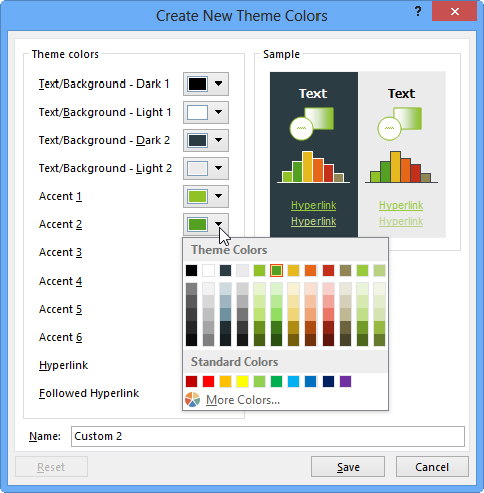
FIGURE 22.16 Choose a custom color if none of the standard colors is appropriate.
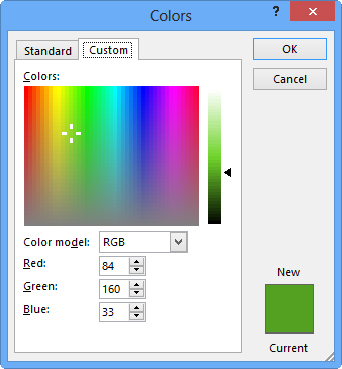
Creating a custom font theme
You can create your own custom font themes, which are then available in all presentations. A custom font theme defines two fonts: one for headings and one for body text. To create a custom font theme, follow these steps:
FIGURE 22.17 Create a new custom font theme by specifying the fonts to use.

Sharing a custom color or font theme with others
A custom color theme or font theme is available only to the currently logged-in user on the PC on which it is created. If you want to share it with another user on the same PC, you can copy it into his or her user folder. In File Explorer (Windows Explorer), start out at C:Usersuser nameAppDataRoamingMicrosoftTemplatesDocument Themes where user name is that user’s login name and then navigate to the appropriate subfolder there: Theme Colors or Theme Fonts.
The default color and font themes are located in C:Program FilesMicrosoft OfficeDocument Theme, in the Theme Colors or Theme Fonts folder, respectively.
Another way to share a custom color or font theme is to save the (design) theme to a theme file (.thmx). See “Creating a new theme” earlier in this chapter. The resulting theme file will contain the custom colors and fonts.
Deleting a custom color or font theme
A custom color or font theme remains until you delete it. The easiest way to do so is to click the button for the appropriate type (Color or Font) on the Slide Master tab in Slide Master view, and then right-click the theme in the gallery and click Delete. Or in other views, you can click the More button in the Variants group of the design tab, point to Color or Font, and then right-click the theme in the gallery and click Delete.
You can also delete the color or font theme from outside of PowerPoint. To delete a theme color, use File Explorer (Windows Explorer) to navigate to this folder: C:Usersuser nameAppDataRoamingMicrosoftTemplatesDocument ThemesTheme Colors where user name is your Windows sign-in name, and you’ll find an .xml file for each of your custom color themes. (You’ll find the font themes in .xml files in the Theme Fonts folder.) Delete the files for the color or font themes that you want to delete.
Changing the Background
The background is the color, texture, pattern, or image that is applied to the entire slide (or slide master), on which everything else sits. By its very definition, it applies to the entire surface of the slide; you cannot have a partial background. However, you can have a background graphic overlaid on top of the background. A background graphic is a graphic image placed on the slide master that complements and works with the background.
It’s important to understand the distinction between a background and a background graphic because even though most themes contain both, they are set up differently. Making the change you want to the overall appearance of your slides often involves changing both. For example, Figure 22.18 shows the Facet theme applied to a slide. The slide background is pure white, and a green background graphic is overlaid on it. This background graphic is composed of several different shapes, colors with different shades of green, plus a few gray straight lines. Each of those graphic objects can be individually edited, moved, or even deleted from the slide master. The white background itself can be changed via the Format Background command.
FIGURE 22.18 A slide’s background is separate from its background graphic(s) if any are present.
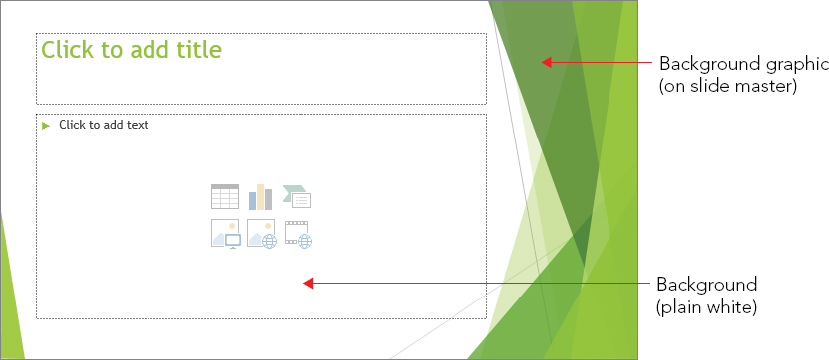
Most themes consist of both background formatting (even if it is just a solid color) and a background graphic. The background graphics included in the built-in themes in PowerPoint are unique to those themes, and not available as separate graphics outside of them. So, for example, if you want the colored shapes shown in Figure 22.18, the only way to get them is to apply the Facet theme. Because the decorative background graphics are unique to each theme, many people choose a theme based on the desired background graphics, and then customize the slide master’s appearance to modify the theme as needed.
Applying a background style
Background styles are preset background formats that come with the built-in themes in PowerPoint. Depending on the theme you apply, different background styles are available. These background styles use the color placeholders from the theme, so their color offerings change depending on the color theme applied.
To apply a background style, follow these steps:
FIGURE 22.19 Apply a preset background style.

You cannot customize background styles or add your own custom background styles; there are always 12 of them, and they are always determined by the theme. If you need a different background, you can apply a custom background fill, as described in the following sections, which lets you modify the background in a variety of ways.
Applying a custom background fill
A custom background fill can include solid colors, gradients, textures, or graphics. Here’s how to specify your own background fill, which involves the following steps:
FIGURE 22.20 Click the option button for the fill type that best fits your needs.

Working with background graphics
In Figure 22.20, one of the fill types you saw on the list was Picture or texture fill. This type of fill covers the entire background with the picture or texture that you specify.
That’s not what we mean by a background graphic in this section, however. A background graphic in the context of the following discussion is an object or a picture overlaid on top of the background on the slide master, like those shapes I pointed out in Figure 22.18. The background graphics complement the background, and might or might not cover the entire background.
Displaying and hiding background graphics
Sometimes a background graphic can get in the way of the slide’s content. For example, on a slide that contains a large chart or diagram, a background graphic around the border of the slide can overlap the content. You don’t have to delete the background graphic entirely to solve this problem; you can turn it off for individual slides. To hide the background graphics on one or more slides, follow these steps:
FIGURE 22.21 Mark the Hide background graphics check box to suppress the background graphics on the selected slide.

Deselect the check box to redisplay the background graphics later as needed.
If you want to hide the background graphics on all the slides that use a particular layout master or slide master, do the following:
Deleting background graphics
The background graphics reside on the slide master, so to remove one, you must use Slide Master view. Follow these steps:
Adding your own background graphics
You can add your own background graphics, either to the slide master or to individual layout masters. This works just like adding any other graphic to a slide, except you add it to the master instead of to an individual slide.
Inserting pictures is covered in greater detail in Chapters 9 and 24, but here are the basic steps for adding a background graphic:
- Click Insert ⇒ Images ⇒ Pictures. Select a picture to insert and click Insert.
- Click Insert ⇒ Images ⇒ Online Pictures. Search for a piece of clip art to use, or an image from another online source, and insert it on the master.
- In any application (including PowerPoint), copy any graphic to the Clipboard by pressing Ctrl+C; then display the master and paste the graphic by pressing Ctrl+V.
Working with Placeholders
Recall from earlier in this chapter that when you enter Slide Master view, one or more slide masters appear in the left pane, with its own subordinate layout masters. The slide master and each layout master has five preset placeholders that you can individually remove or move around. Figure 22.22 points them out on a slide master with the Facet theme applied, but they might be in different locations in other themes:
- Title: The placeholder for the title on each slide
- Text: The main content placeholder on each slide
- Date: The box that displays the current date on each slide
- Slide number: The box that displays the slide number on each slide
- Footer: A box that displays repeated text at the bottom of each slide
FIGURE 22.22 Each slide master contains these placeholders (or can contain them).
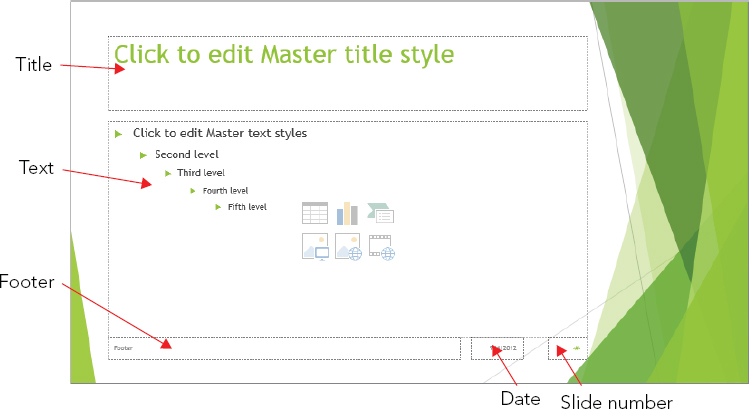
Each of these elements on the slide master trickles down to the layout masters beneath it, so formatting, moving, or deleting one of these elements from the slide master also changes it on each of the layouts.
Formatting a placeholder
You can format the text in each of the placeholders on the slide master just like any regular text, and that formatting carries over to all slides and layouts based on it. For example, if you format the code in the Slide Number box with a certain font and size, it will appear that way on every slide that uses that slide master. You can also format the placeholder boxes just like any other text boxes. For example, you can add a border around the page number’s box, and/or fill its background with color.
Moving, deleting, or restoring placeholders
You can move each of the placeholders on the slide master or an individual layout master. For example, you might decide you want the Footer box at the top of the slide rather than the bottom, or that you want to center the slide number at the bottom of the slide:
- To move a placeholder, click it to select it and then drag its border, just as you did with text boxes in Chapter 21.
- To delete one of the placeholders on the slide master, select its box and press the Delete key on the keyboard. Deleting it from the slide master deletes it from all of the associated layouts as well. It also deletes any special formatting they had, so if you add them back later, you have to reformat them.
- On an individual layout master, you can quickly delete and restore the Title and Footer placeholders by selecting or deselecting the Title and Footers check boxes on the Slide Master tab. The “footer” that this check box refers to is actually all three of the bottom-of-the-slide elements: the actual footer, the date box, and the slide number box.
- You can also individually delete the placeholders from a layout master, the same as you can on a slide master. Just select a placeholder box and press the Delete key.
- To restore deleted Date, Footer, or Slide Number placeholders on an individual layout master, display the Slide Master tab and select the Footers check box. If any of the footer placeholders (Date, Footer, or Slide Number) were previously deleted, they reappear.
- To control the status for each of the placeholders on the slide master, select the slide master in the left pane and then click Slide Master ⇒ Master Layout ⇒ Master Layout to open the Master Layout dialog box. From there, mark the check boxes for the placeholders you want to display or hide and click OK. See Figure 22.23. This action is available only for the slide master, not for individual layout masters.
FIGURE 22.23 Set each placeholder’s on/off status in the Master Layout dialog box.

Displaying the date, number, and footer on slides
Even though the placeholders for Date, Number, and Footer might appear on the slide master, they do not appear on the actual slides in the presentation unless you enable them. This might seem counterintuitive at first, but it’s actually a benefit. PowerPoint enables you to turn the date, number, and footer on and off without having to delete, re-create, or reformat their placeholders. You can decide at the last minute whether you want them to display or not, and you can choose differently for different audiences and situations.
You can control all three areas from the Header and Footer dialog box. To open it, click Insert ⇒ Text ⇒ Header and Footer. Then on the Slide tab, select the check boxes for each of the three elements that you want to use, as shown in Figure 22.24.
FIGURE 22.24 Choose which footer elements should appear on slides.
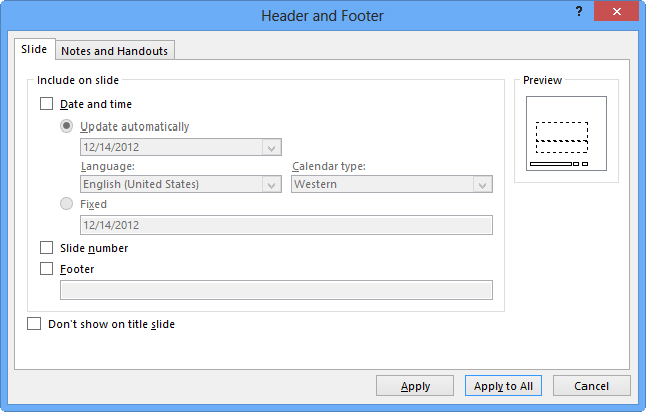
Date and time
You can set Date and Time either to Update Automatically or to Fixed:
- Update automatically: Pulls the current date from the computer’s clock and formats it in whatever format you choose from the drop-down list. You can also select a language and a Calendar Type (although this is probably not an issue unless you are presenting in some other country than the one for which your version of PowerPoint was developed).
- Fixed: Prints whatever you enter in the Fixed text box. When Fixed is enabled, it defaults to today’s date in the m/dd/yyyy format.
Slide number
This option shows the slide number on each slide, wherever the Number placeholder is positioned. You can format the Number placeholder on the slide master with the desired font, size, and other text attributes
By default, slide numbering starts with 1. You can start with some other number if you like by following these steps:
Footer
The footer is blank by default. Select the Footer check box, and then enter the desired text in the Footer box. You can then format the footer text from the slide master as you would any other text. You can also enter the footer text in the Header and Footer dialog box’s Footer text box.
Don’t show on title slide
This check box in the Header and Footer dialog box suppresses the date/time, page number, and footer on slides that use the Title Slide layout. Many people like to hide those elements on title slides for a cleaner look and to avoid repeated information (for example, if the current date appears in the subtitle box on the title slide).
Customizing and Creating Layouts
In addition to customizing the slide master (including working with its preset placeholder boxes, as you just learned), you can fully customize the individual layout masters.
A layout master takes some of its settings from the slide master with which it is associated. For example, by default it takes its background, fonts, theme colors, and preset placeholder positioning from the slide master. But the layout master also can be individually customized; you can override the slide master’s choices for background, colors, and fonts; and you can create, modify, and delete various types of content placeholders.
Understanding content placeholders
You can insert seven basic types of content on a PowerPoint slide: Text, Picture, Chart, Table, Diagram, Media (video or sound), and Clip Art. A placeholder on a slide master or layout master can specify one of these types of content that it will accept, or you can designate it as a Content placeholder, such that it will accept any of the seven types. Most of the layouts that PowerPoint generates automatically for its themes use the Content placeholder type because it offers the most flexibility. By making all placeholders Content placeholders rather than a specific type, PowerPoint can get by with fewer separate layout masters because users will choose the desired layout based on the positioning of the placeholders, not their types.
A Content placeholder appears as a text placeholder with a small palette of buttons in the center, one for each of the content types. Each content placeholder can hold only one type of content at a time, so as soon as the user types some text into the content placeholder or clicks one of the buttons in the palette and inserts some content, the placeholder becomes locked into that one type of content until the content is deleted from it.
You can move and resize a placeholder on a layout master as you would any other object. Drag a selection handle on the frame to resize it, or drag the border of the frame (not on a selection handle) to move it.
Adding a custom placeholder
You can add a custom placeholder to an individual layout master. This makes it easy to build your own custom layouts.
To add a custom placeholder, follow these steps:
FIGURE 22.25 Create a new placeholder on a slide.

Deleting and restoring a custom placeholder
To delete a custom placeholder, select it and press the Delete key, just as you learned to do earlier with the preset placeholders.
The difference between custom and preset placeholders is not in the deleting, but rather in the restoring. You can immediately undo a deletion with Ctrl+Z, but you cannot otherwise restore a deleted custom placeholder from a layout master. PowerPoint retains no memory of the content placeholders on individual layouts. Therefore, you must re-create any content placeholders that you have accidentally deleted.
Overriding the slide master formatting for a layout
You can apply formatting to a layout in almost exactly the same ways as you apply formatting to a regular slide or to a slide master. Only a few things are off-limits:
- You cannot apply a different theme to individual layouts under a common slide master. To use a different theme for some slides, you have to create a whole new slide master (covered later in this chapter).
- You cannot apply a different font, color, or effect theme, because these are related to the main theme and the slide master. If you need different fonts or colors on a certain layout, specify fixed font formatting for the text placeholders in that layout, or specify fixed color choices for objects.
- You cannot delete a background graphic that is inherited from the slide master; if you want it only on certain layouts, delete it from the slide master, and then paste it individually onto each layout desired, or select Hide Background Graphics from certain layouts.
- You cannot change the slide orientation (portrait or landscape) or the slide size.
So what can you do to an individual layout, then? Plenty. You can do the following:
- Apply a different background.
- Reposition, resize, or delete preset placeholders inherited from the slide master.
- Apply fixed formatting to text placeholders, including different fonts, sizes, colors, attributes, indents, and alignment.
- Apply formatting using theme colors and theme fonts.
- Apply fixed formatting to any placeholder box, including different fill and border styles and colors.
- Create manual text boxes and type any text you like into them. You might do this to include copyright notice on certain slide layouts, for example. However, keep in mind that such text boxes can’t be edited on the individual slides.
- Insert pictures or clip art that should repeat on each slide that uses a certain layout.
Creating a new layout
In addition to modifying the existing layouts, you can create your own brand-new layouts, defining the exact placeholders you want. To create a new layout, follow these steps:
Renaming a layout
Layout names can help you determine the purpose of a layout if it is not obvious from viewing its thumbnail image.
To change the name of a layout, or to assign a name to a new layout you’ve created, follow these steps:
Duplicating and deleting layouts
You might want to copy a layout to get a head start on creating a new one. To copy a layout, right-click the layout in Slide Master view and choose Duplicate Layout. A copy of the layout appears below the original.
If you are never going to use a certain layout, you might as well delete it; every layout you can delete makes the file a little bit smaller. To delete a layout, right-click the layout in Slide Master view and choose Delete Layout.
Copying layouts between slide masters
When you create additional slide masters in the presentation, any custom layouts you’ve created for the existing slide masters do not carry over. You must manually copy them to the new slide master.
To copy a layout from one slide master to another, follow these steps:
You can also copy layouts between slide masters in different presentations. To do so, open both presentation files, and then perform the previous steps. The only difference is that after step 2, you must switch to the other presentation’s Slide Master view.
Managing Slide Masters
Let’s review the relationship one more time between slide masters and themes. A theme is a set of formatting specs (colors, fonts, and effects) that can be used in PowerPoint, Word, or Excel. Themes are not applied directly to slides — they are applied to slide masters, which govern the formatting of slides. The slide masters exist within the presentation file itself. You can change them by applying different themes, but they are essentially “built in” to the presentation file.
When you change to a different theme for all of the slides in the presentation, your slide master changes its appearance. You can tweak that appearance in Slide Master view. As long as all of the slides in the presentation use the same theme, you need only one slide master. However, if you apply a different theme to some of your slides, you need another slide master, because a slide master can have only one theme applied to it at a time. PowerPoint automatically creates the additional slide master(s) for you when you apply a different design to some slides but not to others.
If you later reapply a single theme to all of the slides in the presentation, you do not need multiple slide masters anymore, so the unused one is automatically deleted. In addition to all this automatic creation and deletion of slide masters, you can also manually create and delete slide masters on your own. Any slide masters that you create manually are automatically preserved, even if they aren’t always in use. You must manually delete them if you don’t want them anymore.
In the following sections, you learn how to create and delete slide masters manually, and how to rename them. You also learn how to lock one of the automatically created slide masters so that PowerPoint does not delete it if it falls out of use.
Creating and deleting slide masters
To create another slide master, start out in Slide Master view (of course), and then click Slide Master ⇒ Edit Master ⇒ Insert Slide Master. The new slide master appears below the existing slide master(s) and all its individual layout masters in the left pane of Slide Master view. From there, just start customizing it. You can apply a theme to it, modify its layouts and placeholders, and all the usual things you can do to a slide master. Another way to create a new slide master is to duplicate an existing one. To do this, right-click the existing slide master and choose Duplicate Master.
To delete a slide master, select it in Slide Master view (make sure you select the slide master itself, not just one of its layouts) and press the Delete key. If any of that slide master’s layouts were applied to any slides in the presentation, those slides automatically convert to the default slide master’s equivalent layout. If no exact layout match is found, PowerPoint does its best: It uses its default Title and Content layout and includes any extra content as orphaned items.
Renaming a slide master
Slide master names appear as category headings on the Layout list as you are selecting layouts. For example, in Figure 22.26, the slide master names are Facet and Intensity.
FIGURE 22.26 Slide master names form the category titles on the Layout list.
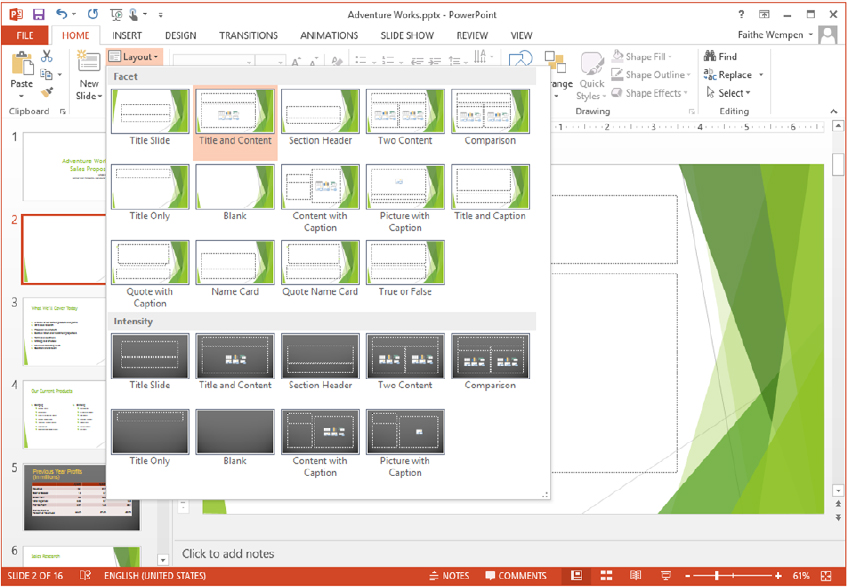
To rename a slide master, follow these steps:
Preserving a slide master
Unless you have created the slide master yourself, it is temporary. Slide masters come and go as needed, as you format slides with various themes. To lock a slide master so that it doesn’t disappear when no slides are using it, right-click the slide master and choose Preserve Master, or click Slide Master ⇒ Edit Master ⇒ Preserve. The Preserve button on the Slide Master tab appears selected, indicating the slide master is preserved. To unpreserve it, click the Preserve button again, or right-click the slide master again and choose Preserve Master. See Figure 22.27.
FIGURE 22.27 The Preserve Master command saves a slide master so that PowerPoint cannot automatically delete it.
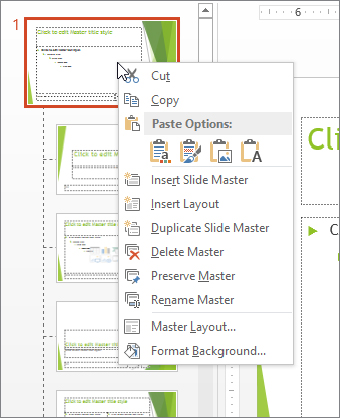
Summary
In this chapter you learned how themes and slide masters make it easy to apply consistent formatting in a presentation, and how layout masters are associated with slide masters and provide consistent layouts for the slides based on them. You learned:
- The difference between themes and templates.
- How to apply a theme and customize it with color themes, font themes, and effect themes.
- How to save, rename, and delete themes.
- How to use masters and layouts to control the presentation and slide content.
- How to work in Slide Master view to make various changes to the master and layouts.
